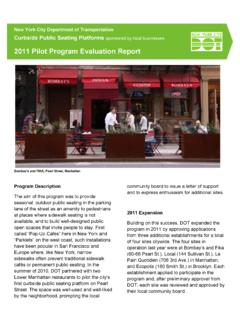Transcription of MENTORING PROGRAMS: A FRAMEWORK TO …
1 A R T I C L E. MENTORING programs : A. FRAMEWORK TO INFORM. PROGRAM DEVELOPMENT, RESEARCH, AND EVALUATION. Michael J. Karcher University of Texas at San Antonio Gabriel P. Kuperminc Georgia State University Sharon G. Portwood University of Kansas Kansas City Cynthia L. Sipe Youth Development Strategies, Inc. Andrea S. Taylor Temple University As MENTORING programs have proliferated, considerable variation in approaches to programmatic MENTORING has emerged. Concomitant confusion exists about the context, structure, and goals that constitute MENTORING as a distinct intervention. This article presents a brief summary of what is currently known about different approaches to MENTORING and proposes a FRAMEWORK that identifies both the common and the specific elements among different youth MENTORING approaches.
2 Rather than focusing solely on the participants and contexts of MENTORING programs , such as peer- or school- based MENTORING , as the key elements that differentiate programs , the authors suggest that more fruitful program development and research will result from a closer examination of the context, structure, and goals of programs , as well as of three critical program elements: content, infrastructure, and dosage. To understand better how and under what conditions MENTORING works, program developers and researchers should test hypotheses regarding the influences of these program elements based on theory-driven expectations about the interrelationships among proximal, enabling, and distal outcomes of MENTORING programs .
3 2006 Wiley Periodicals, Inc. Correspondence to: Michael J. Karcher, College of Education and Human Development, University of Texas at San Antonio, 501 West Durango Blvd., Suite , San Antonio, TX 78207. E-mail: JOURNAL OF COMMUNITY PSYCHOLOGY, Vol. 34, No. 6, 709 725 (2006). Published online in Wiley InterScience ( ). 2006 Wiley Periodicals, Inc. DOI: 710 Journal of Community Psychology, November 2006. Although the idea of MENTORING is not a new one, in recent years, there has been an increased focus on programs designed to facilitate both formal and informal MENTORING relationships, with practitioners, researchers, policy makers, and funders all looking to MENTORING as a promising form of intervention for children and youth.
4 Reports suggest there are at least 4,500 agencies providing MENTORING (DuBois & Karcher, 2005), includ- ing 500 Big Brothers/Big Sisters of America agencies. Popular national initiatives, such as America's Promise, and federal legislation promoting MENTORING , including the No Child Left Behind Act of 2001 and Title IV-B of the Social Security Act, which provides funding for the MENTORING Children of Prisoners Program, reflect the widespread belief that the presence of a mentor in the life of a young person not only supports healthy growth and development, but also serves as a protective factor against many of the risks facing today's youth.
5 The momentum of current MENTORING initiatives, including related policy and pro- gram initiatives at the local, state, and national levels, presents a unique opportunity for advancing knowledge in this area. Conversely, the wholesale acceptance of MENTORING as an effective intervention strategy may be an obstacle to systematic efforts to examine MENTORING critically. Specifically, given the prevailing assumption that MENTORING is valu- able, it may be difficult to ensure that adequate resources are allocated to research and evaluation. Despite the current level of interest and the number of MENTORING initiatives, definitional and conceptual clarity are still needed in order to develop a rigorous research base.
6 The question of program effectiveness depends, in part, on specifying the type of program, the context, and the nature of activities and goals around which pro- grams are organized. This article attempts to put forth definitions regarding the struc- ture, context, content, and outcomes of MENTORING to guide future research on the effectiveness of specific MENTORING programs . CONCEPTUALIZATION. The diversity of MENTORING programs is both a strength and a liability for the establish- ment of a well-defined research base on the effectiveness of MENTORING . To date, pro- grams typically have been shaped by their developers and assigned whatever name seemed to be the best label for that particular approach.
7 As a result, several forms of MENTORING ( , peer, group, and e- MENTORING ) have been plagued by ill-conceived and inconsistent definitions. We propose a FRAMEWORK for conceptualizing the elements of MENTORING programs along the dimensions of context, structure, and goals. Program contexts refer to the location of the meetings. Structure refers to the nature of the mentee mentor relationship, such as one-on-one compared to group MENTORING and adult-with-youth compared to cross-age peer MENTORING . The goals of a program shape the activities that occur in the match, and these activities fall along a continuum from task- or skill-focused to relational and develop- mental in nature.
8 We will consider issues relating to common and unique elements of men- toring programs , with specific attention to issues of infrastructure and dosage. MENTORING Contexts Program contexts can be described as field based or site based (Rhodes, 2002). Each con- text imposes unique constraints on the MENTORING relationships and program operations. Journal of Community Psychology DOI: Program FRAMEWORK 711. Field-Based MENTORING . Field-based MENTORING refers to programs in which a sponsoring agency coordinates and supports mentor mentee matches, but mentors and mentees typically interact at mutually convenient times and locations. Probably the best-known manner in which MENTORING occurs, field-based MENTORING offers the greatest freedom for mentors and mentees to discover shared interests and to explore a range of educa- tional and recreational opportunities.
9 Site-Based MENTORING . Site-based MENTORING broadly refers to those programs in which mentors and mentees interact primarily in one of a variety of specific MENTORING sites, including schools, community agencies, youth development centers, religious contexts, the work- place, and hospitals or clinics. Site-based programs often are organized in terms of the context as well as the structure and goals of the program ( , to facilitate career devel- opment through workplace MENTORING ). Approximately 45% of MENTORING programs are site based, and 70% of site-based programs are found in schools (Sipe & Roder, 1999). School-based MENTORING is perhaps the most common site-based context for mentor- ing.
10 School-based MENTORING refers to programs that take place on school grounds, typically during regular school hours for 1 hour each week. In addition to their better-known field-based MENTORING programs , Big Brothers/Big Sisters (BBBS) organizations have developed school-based models, in which adult mentors or high school students work as Bigs with younger students. Not only can such programs offer easy access to mentees and convenience for mentors but, from an operational standpoint, they also can be implemented at relatively low cost. Moreover, school-based mentors may provide an addi- tional advocacy and problem-solving resource for youth.






